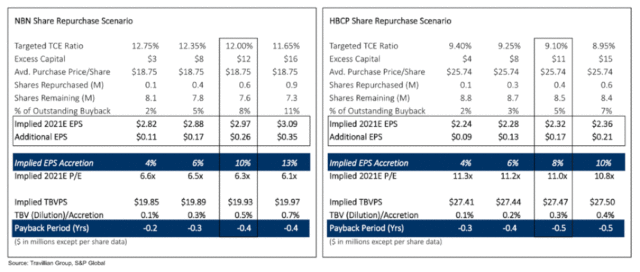– Jamie Dimon, 2018 Shareholder Letter
Backdrop on Share Repurchases. With slower loan growth likely and ample capital ratios compared to the last economic downturn, it seems buybacks could presently be considered by bank management teams, particularly when thinking about raising sub-debt as a tool to do so. However, everyone’s crystal ball on the economic path from here is a bit hazy, which is why many banks trade around tangible book value in the first place. When things are uncertain there is a tendency to run a bank with excess capital – perhaps it will be needed to absorb credit losses, or an opportunity to buy another coveted (or distressed) institution might arise.
Over time, banks have used share repurchases as a tool to manage capital, particularly those growing slower but possessing solid profitability levels. Recall the internal growth rate of capital is (ROA x earnings retention rate). Many banks historically have managed dividend payout ratios to ~35% of earnings, which creates dividend stability and the ability to grow the balance sheet at a manageable pace relative to economic growth. Smaller banks tend to have payout ratios in the 20% range, as they typically can grow faster than larger regional franchises (and may be less profitable as well).
Why Buybacks Get Bad Press. While share repurchases are nicely accretive to EPS at reasonable valuations, investors prefer that banks use their capital for growth and long-term investment in their franchise. Being a habitual re-purchaser of shares can send a message that management is not able to find ways to invest in the franchise, or it has positioned the franchise poorly for organic growth. Sometimes buybacks are consummated and the shares decline thereafter; timing is difficult. Lastly, investors may think a management team is only defending the stock price (and not focused on creating long-term value).
But Buybacks Can Be Appropriate. As Jamie Dimon wrote in his 2018 shareholder letter, buying back stock should be considered only when either a bank cannot invest (sometimes as a result of regulatory policies) or the bank is generating excess capital not expected to be used in the next few years. As he indicates, buying back stock is an important capital tool – as long as you are buying it back at a reasonable price. Today’s prices are very reasonable in my view. Much like waiting until it seems too late to buy tech stocks, once you really want to buy your own stock it may be a much tougher decision. Economic certainty should eventually bring higher valuations to the sector.
Buybacks vs. M&A. In Travillian’s recent investment banking webinar, Scott Clark, Managing Director and Co-Head of Financial Services Investment Banking at Piper Sandler, suggested that sometimes buying back your own stock is better than doing a deal. This is because accretion is more certain and the risk of dilution is lower. The future of a deal is unknowable, but the math on a share repurchase is straightforward. This may be an unpopular concept for many CEOs to admit, as banking is an industry where size correlates directly with executive compensation.
How to Contemplate Buybacks in General. In the current setting, I think management should look at having some dry powder for potential deals and decide on a level of excess capital over which share repurchases would be utilized. Following that, the other criteria would be thinking about the “glide path” of loan deferrals. If a bank is seeing deferrals move toward the low-single digit range, current earnings power and the provisioning built so far in 2020 is likely able to absorb whatever might be coming from a credit loss perspective.
Buybacks in Today’s Environment. Typically, banks are looking at buying back shares at a multiple of tangible book value and having to think about an earn-back period, as well as the opportunity cost of doing other things – usually making loans. With today’s prices, there is minimal, if any, dilution to tangible book value. Also, the opportunity cost is very compelling. There is no comparison between making a loan at 3% to 4% compared to the earnings yield (inverse of P/E ratio) on buying back stock. Repurchasing shares at 8-10x earnings means an earnings yield of 10.0% to 12.5%. Additionally, there is no CECL reserve to make on the share repurchase or administration/origination costs, etc.
The Regulator’s Angle. As an institution grows, regulators will be more involved in the capital allocation and buyback scenario conversation. A community bank may provide an easier regulatory backdrop for a share repurchase to be consummated before it is obvious to the market what bank management might already know – that the stock is undervalued relative to the fundamentals. Most bank executives believe their stock is perpetually too cheap, partly a function of being in a leveraged, cyclical industry.
Looking at Examples. Some smaller community banks, and a few regional banks, have announced share buybacks since 2Q20 earnings. I think highlighting a few of these, along with tables illustrating the accretion and overall dynamics, will support the conversations bank management teams should spend time discussing in the boardroom. This will help shed light on whether a buyback might be a solid consideration while bank stocks remain at low prices.
Two examples – the first is Northeast Bank (NBN), a $1.2B bank headquartered in Maine. They announced an 8% share repurchase plan in late July before announcing earnings. Assuming they repurchase the $10M announced, it would be 10% accretive to EPS and 0.5% accretive to tangible book value. On August 31st, $2.6B Home Bancorp (HBCP) announced a 5% share repurchase that we estimate will be 8% accretive to earnings and 0.3% accretive to TBVPS.
Travillian’s Banking and FinTech Practice provides Search and Talent Advisory services to depository institutions across the country. Established in 1998, the firm has built a unique platform that touches every corner of the industry. To learn more, click here, or get in touch below!
|
Brian Love, Head of Banking & Fintech
(484) 680-6950 | blove@travilliangroup.com |













